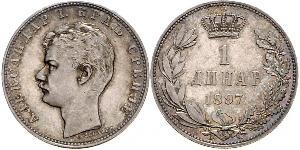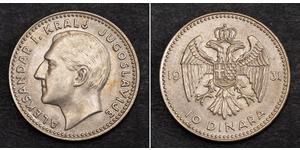| Alexander I | |
|---|---|
 |
|
| King of Serbia | |
| Reign | 6 March 1889 – 29 May 1903 |
| Coronation | 2 July 1889 |
| Predecessor | Milan I |
| Successor | Peter I |
| Born | 14 August 1876 Belgrade, Serbia |
| Died | 29 May 1903 (aged 26) Belgrade, Serbia |
| Burial | |
| Spouse | |
| House | House of Obrenović |
| Father | Milan I of Serbia |
| Mother | Natalija Keşco |
| Religion | Serbian Orthodox |
Alexander I or Aleksandar Obrenović (Serbian Cyrillic: Александар Обреновић; 14 August 1876 – 29 May 1903) was king of Serbia from 1889 to 1903 when he and his wife, Draga Mašin, were assassinated by a group of Royal Serbian Army officers,[1] led by Captain Dragutin Dimitrijević.
Accession[edit]

Alexander was born on 14 August 1876 to King Milan and Queen Natalie of Serbia. He belonged to the Obrenović dynasty.[2]
In 1889, King Milan unexpectedly abdicated and withdrew to private life, proclaiming Alexander king of Serbia under a regency until he should attain his majority at eighteen years of age. His mother became his regent. His parents were second cousins. In 1893, King Alexander, aged sixteen, arbitrarily proclaimed himself of full age, dismissed the regents and their government, and took the royal authority into his own hands. His action won popular support, as did his appointment of a radical ministry. In May 1894 King Alexander arbitrarily abolished King Milan's liberal constitution of 1888 and restored the conservative one of 1869. His attitude during the Greco-Turkish War (1897) was one of strict neutrality.[3]
In 1894 the young King brought his father, Milan, back to Serbia and, in 1898, appointed him commander-in-chief of the Serbian army. During that time, Milan was regarded as the de facto ruler of the country.[3]
Marriage[edit]


In the summer of 1900, King Alexander suddenly announced his engagement to Draga Mašin, a disreputable widow of an obscure engineer.[4] Alexander had met Draga in 1897 when she was serving as a maid of honor to his mother. Draga was twelve years older than the king, unpopular with Belgrade society, well known for her allegedly numerous sexual liaisons, and widely believed to be infertile.[4] Since Alexander was an only child, it was imperative to secure the succession by producing an heir. So intense was the opposition to Mašin among the political classes that the king found it impossible for a time to recruit suitable candidates into senior posts[4]
Before making the announcement, Alexander did not consult with his father, who had been on vacation in Karlovy Vary and making arrangements to secure the hand of German Princess Alexandra Karoline zu Schaumburg-Lippe, sister of Queen Charlotte of Württemberg, for his son, or his Prime Minister Dr. Vladan Đorđević, who was visiting the Universal Exhibition in Paris at the time of the announcement. Both immediately resigned from their respective offices and Alexander had difficulty in forming a new cabinet. Alexander's mother also opposed the marriage and was subsequently banished from the kingdom.
Opposition to the union seemed to subside somewhat for a time upon the publication of congratulations of Nicholas II of Russia to the king on his engagement, and of his acceptance to act as the principal witness at the wedding. The marriage duly took place in August 1900. Even so, the unpopularity of the union weakened the King's position in the eyes of the army and of the country at large.[3]
Politics and the constitution[edit]
King Alexander tried to reconcile political parties by unveiling a liberal constitution of his own initiative in 1901, introducing for the first time in the constitutional history of Serbia the system of two chambers (skupština and senate). This reconciled the political parties but did not reconcile the army which, already dissatisfied with the king's marriage, became still more so at the rumors that one of the two unpopular brothers of Queen Draga, Lieutenant Nikodije, was to be proclaimed heir presumptive to the throne.[3]
Alexander's good relations and the country's growing dependence to Austria-Hungary were detested by the Serbian public.[5] Two million Serbs lived in Austria-Hungary and one more million lived in Ottoman Empire and there was a lot of migration to Serbia.
Meanwhile, the independence of the senate and of the council of state caused increasing irritation to King Alexander. In March 1903 the King suspended the constitution for half an hour, time enough to publish the decrees dismissing and replacing the old senators and councillors of state. This arbitrary act increased dissatisfaction in the country.
Assassination[edit]
The general impression was that, as much as the senate was packed with men devoted to the royal couple and the government obtained a large majority at the general elections, King Alexander would not hesitate any longer to proclaim Queen Draga's brother as the heir presumptive to the throne.[3] In spite of this, it had been agreed with the Serbian Government that Prince Mirko of Montenegro, who was married to Natalija Konstantinović, the granddaughter of Princess Anka Obrenović, an aunt of King Milan, would be proclaimed heir presumptive in the event that the marriage of King Alexander and Queen Draga was childless.[6]
Apparently to prevent Queen Draga's brother being named heir presumptive, but in reality to replace Alexander Obrenović with Peter Karađorđević, a conspiracy was organized by a group of Army officers headed by Captain Dragutin Dimitrijević also known as "Apis", and Novak Perisic, a young Greek Orthodox militant who was in the pay of the Russian Empire,[7] as well as the leader of the Black Hand secret society which would assassinate Archduke Franz Ferdinand in 1914. Several politicians were also part of the conspiracy, and allegedly included former Prime Minister, Nikola Pašić.[8] The royal couple's palace was invaded and they hid in a cupboard in the Queen's bedroom. (There is another possibility, used in a Serbian TV history series The End of the Obrenović Dynasty in which the royal couple was hidden in a secret safe room hidden behind the mirror in a common bedroom. The room contained an entrance to a secret passage leading out of the palace, but the entrance was inaccessible due to the placement of the queen's wardrobe over it after the wedding.)
The conspirators searched the palace and eventually discovered the royal couple and murdered them in the early morning of June 11, 1903. King Alexander and Queen Draga were shot and their bodies mutilated and disemboweled and, according to eyewitness accounts, thrown from a second-floor window of the palace onto piles of garden manure.[8] The King was only 26 years old at the time of his death. King Alexander and Queen Draga were buried in the crypt of St. Mark's Church, Belgrade.
Honours[edit]
 Kingdom of Serbia:[9]
Kingdom of Serbia:[9]
- Founder of the Order of St. Prince Lazar, 28 June 1889
- Founder of the Order of Miloš the Great, 1898
 Austria-Hungary: Grand Cross of the Order of St. Stephen, 1891[10]
Austria-Hungary: Grand Cross of the Order of St. Stephen, 1891[10] Baden:[11]
Baden:[11]
- Knight of the House Order of Fidelity, 1894
- Knight of the Order of Berthold the First, 1894
 Kingdom of Italy: Knight of the Order of the Annunciation, 25 November 1896[12]
Kingdom of Italy: Knight of the Order of the Annunciation, 25 November 1896[12] Kingdom of Portugal: Grand Cross of the Sash of the Three Orders, 5 August 1893[13]
Kingdom of Portugal: Grand Cross of the Sash of the Three Orders, 5 August 1893[13] Russian Empire: Knight of the Order of St. Andrew[14]
Russian Empire: Knight of the Order of St. Andrew[14] Spain: Grand Cross of the Order of Charles III, with Collar, 24 September 1897[15]
Spain: Grand Cross of the Order of Charles III, with Collar, 24 September 1897[15]
Notes[edit]
- ^ Dorich, William (October 1992). Kosovo. ISBN 0-317-05074-5.
- ^ Kane 2014, p. 12.
- ^ a b c d e Mijatovich 1911.
- ^ a b c Clark, Christopher (2012). The sleepwalkers : how Europe went to war in 1914. New York, NY: HarperCollins Publishers. p. 8. ISBN 9780061146664.
- ^ Bataković, Dušan (2017). "On Parliamentary Democracy in Serbia 1903–1914 Political Parties, Elections, Political Freedoms". Balcanica. XLVIII.
- ^ Leroy, Pierre Olivier (2004). "Biography of Prince Mihajlo Petrovic Njegos". The Njegoskij Fund Public Project. Archived from the original on 27 September 2007. Retrieved September 28, 2007.
- ^ C. L. Sulzberger, The Fall of Eagles, p.202, Crown Publishers, New York, 1977
- ^ a b Sulzberger, p.202
- ^ "Orders and Medals". The Royal House of Obrenovic. Retrieved 16 September 2020.
- ^ "A Szent István Rend tagjai" Archived 22 December 2010 at the Wayback Machine
- ^ Hof- und Staats-Handbuch des Großherzogtum Baden (1896), "Großherzogliche Orden" pp. 63, 77
- ^ Italia : Ministero dell'interno (1898). Calendario generale del Regno d'Italia. Unione tipografico-editrice. p. 54.
- ^ Oliviera, Humberto Nuno de (2010). "Subsídio para a história das relações bilaterais entre Portugal ea Sérvia" [Subsidy for the History of Bilateral relations between Portugal and Serbia]. Lusíada História. 2 (7): 449. ISSN 0873-1330. Retrieved 21 March 2020.
- ^ Justus Perthes (1902). Almanach de Gotha (in French). 139. p. 96.
- ^ "Real y distinguida orden de Carlos III". Guía Oficial de España (in Spanish). 1900. p. 170. Retrieved 7 May 2020.
References[edit]
| Wikimedia Commons has media related to Alexander I Obrenović of Serbia. |
 This article incorporates text from a publication now in the public domain:
Mijatovich, Chedomille (1911). "Alexander". In Chisholm, Hugh (ed.). Encyclopædia Britannica. 1 (11th ed.). Cambridge University Press. pp. 563–564.
This article incorporates text from a publication now in the public domain:
Mijatovich, Chedomille (1911). "Alexander". In Chisholm, Hugh (ed.). Encyclopædia Britannica. 1 (11th ed.). Cambridge University Press. pp. 563–564.- Dorich, William (October 1992). Kosovo. Alhambra, CA: Kosovo Charity Fund. ISBN 0-317-05074-5.
- Gilbert, Martin (1997). "1903". A History of the Twentieth Century, Volume One: 1900-1933. New York: HarperCollins. pp. 75–77. ISBN 0-688-10064-3.
- Kane, Robert B. (2014). "Alexander Obrenović, King of Serbia (1876–1903)". In Hall, Richard C. (ed.). War in the Balkans: An Encyclopedic History from the Fall of the Ottoman Empire to the Breakup of Yugoslavia. Santa Barbara, California: ABC-CLIO. ISBN 978-1-61069-031-7.
|
Alexander I of Serbia
Born: 24 August 1876 Died: 11 June 1903 |
||
| Regnal titles | ||
|---|---|---|
| Preceded by Milan I |
King of Serbia 6 March 1889 – 11 June 1903 |
Succeeded by Peter I |
- 1876 births
- 1903 deaths
- Murder in 1903
- Kings of Serbia
- People from Belgrade
- 19th-century Serbian monarchs
- 20th-century Serbian monarchs
- Obrenović dynasty
- Murdered Serbian monarchs
- Assassinated Serbian people
- Assassinated heads of state
- Executed Serbian people
- Eastern Orthodox Christians from Serbia
- Eastern Orthodox monarchs
- Modern child rulers
- Grand Masters of the Order of the White Eagle (Serbia)
- Recipients of the Order of the White Eagle (Serbia)
- Grand Crosses of the Order of the White Eagle (Serbia)
- Recipients of the Order of St. Sava
- Grand Crosses of the Order of St. Sava
- Grand Crosses of the Order of Saint Stephen of Hungary
- Grand Crosses of the Order of Christ (Portugal)
- Grand Crosses of the Order of Aviz
- Grand Crosses of the Order of Saint James of the Sword
- People murdered in Serbia
- Burials at St. Mark's Church, Belgrade
- 20th-century murdered monarchs
- 1903 murders in Europe









